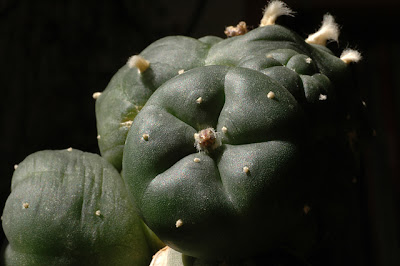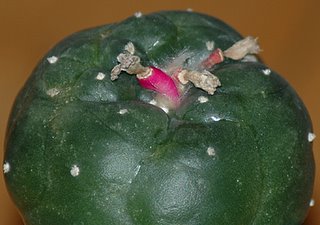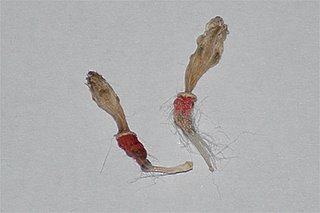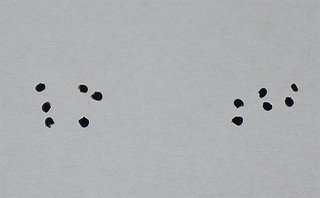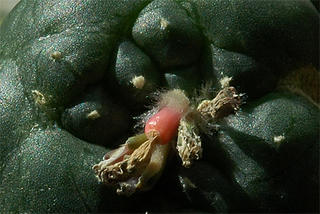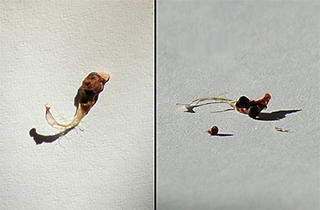In the article The Littlest Lophophora Šnicer, Bohata and Myšák detail the discovery of the new species Lophophora alberto-vojtechii and expand on the description originally given in the June 2008 issue of Cactus & Co.
The article also gives a key to the species of Lophophora which are divided into two sections Lophophora and Diffusae. These sections were originally introduced by the same authors in the booklet Genus Lophophora Coulter - Kaktusy special 2, 2005 and the division was based primarily on chemical composition but also on other factors like habitat, incompatibility of the species, rib numbers and morphology. Members of the Lophophora section are characterized by having concentrations of the psychotropic (mind-altering) alkaloid mescaline ranging from 15–30% of the total alkaloid content, while members of the Diffusae section contain a maximum of 1.3% mescaline. Šnicer et al. recognize five species of Lophophora.
| SECTION LOPHOPHORA |
|---|
| L. williamsii (Salm-Dyck) Coulter |
| SECTION DIFFUSAE |
|---|
| L. diffusa (Croizat) Bravo |
| L. fricii Habermann |
| L. koehresii (J. Ríha) Bohata, Myšák & Šnicer |
| L. alberto-vojtechii J. Bohata, V. Myšák & J. Šnicer |
The following key to the species of Lophophora assumes that L. alberto-vojtechii is allied with the non-mescaline-prevalent species, i.e. it is placed in the Diffusae section.
| KEY TO THE SPECIES OF LOPHOPHORA | ||
|---|---|---|
| 1 | 15–30% mescaline in total alkaloids, epidermis tough and thick | Section Lophophora, L. williamsii |
| 1 | Maximum 1.3% mescaline in total alkaloids; thin, fine epidermis | Section Diffusae, 2 |
| 2 | Seed hilum wide (almost circular), testa not nodulated but reticulated | L. koehresii |
| 2 | Seed hilum V–shaped, testa nodulated (outer cell walls protruding), individual testa cells clearly demarcated | 3 |
| 3 | Usually five (rarely eight) ribs, stem solitary in nature, miniature (rarely exceeding 25 mm in diameter) | L. alberto-vojtechii |
| 3 | Up to 21 ribs, stem solitary or branching in nature | 4 |
| 4 | Flowers dirty white with touch of yellow (rarely pinkish); fruits white to dark pink, usually pale pink; occurring in Queretaro, Mexico | L. diffusa |
| 4 | Flowers usually light pink to dark purple-pink, also white; fruits pink to dark purple-pink (when flower is white the fruit is always dark purple-pink); Coahuila, Mexico | L. fricii |
Seed morphology is an important factor in the above key. In their original publication on Lophophora alberto-vojtechii Šnicer et al. included SEM images illustrating the differences between the seeds of the various Lophophora species, these images along with their description are included below (Šnicer et al. attribute the SEM images to Gerhard Köhres; the images below are not scanned from the article but based on the ones included in the online French version of the article - just to make sure that credit is given where credit is due ;-)









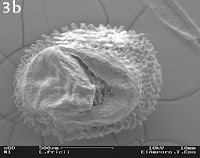






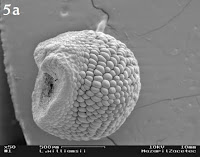







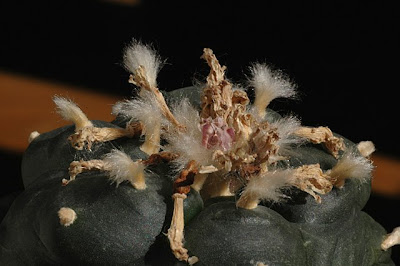



_20070421.jpg)
_20070421.jpg)
